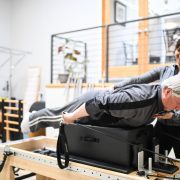Is Rest or Movement best for Back Pain?
Is Rest or Movement best for Back Pain?
When you’re in pain – especially if it’s back pain – your first inclination may be to lay off all activity and rest. But is this really the best thing to do?
When it comes to back pain – my answer is usually “No”.
But I understand why this advice might sound strange or counter-intuitive. It’s scary to move when you’re in pain. And how do you know which exercise is best for your back when it hurts? Plus, advice from the medical community often conflicts with current research. Many people suffering from back pain – especially if it’s an acute injury or episode – are told to rest, ice, and take anti-inflammatories. They are told to limit their movement and activity until their pain goes away. Well science says that 80% of all back problems are mechanical in nature – which means they respond best to movement – even if your back pain is acute.
Let me help you understand.
Mechanical pain occurs when something in your joint (and your spine is made up of a bunch of joints) is restricted in a way that obstructs your normal movement. It’s why back pain is often accompanied by stiffness.
The obstruction can be caused by any structure in your spine. Such as a bulging disc, ligament, or even abnormalities from arthritis. What the research has found with mechanical pain is that if you move in the right way – usually in a specific direction – you can “release” the obstruction. When you’re able to move normally again without stiffness – you have less pain.
Therefore, although early movement is good for your back when you’re in pain, it’s critical you pick the right type of movement. Some movements and positions will aggravate your back, especially if it’s acute. Others will accelerate your healing. Generally speaking, gentle movement like walking is considered one of the best things you can do when your back is hurting, along with gentle mobility exercises that are direction-specific. More often than not you’ll want to avoid movements that involve bending forward and any stretches in this direction. If your back pain involves an irritated nerve or bulging disc – forward stretches such as a child’s pose may feel good in the moment. However, they could prolong or possibly worsen your problem.
The only way to know exactly which movement you should do for your particular back pain is to get a proper assessment from a mechanical pain expert. But when it comes to lower back pain, these are the general patterns that we see for movement that is good for your back.
So what about rest? Why is it not advised?
Although most back pain will go away on its own with time – and rest doesn’t necessarily “hurt” you per say – the problem with resting instead of moving is that it can prolong your healing time. This can trick you into thinking your back problem is gone when it’s really not.
Just because your pain is gone – doesn’t mean your problem is gone. If you’ve got an underlying restriction in your spine that’s causing mechanical back pain, it’s possible to be pain free until you move a certain way again that tweaks your back.
Ever “throw your back out” sneezing or getting out of bed in the morning? It’s because you let an underlying mechanical back problem linger. Perhaps every time you hurt your back you rest until the pain goes away. Well, as we just learned, if your back pain happens to be mechanical in nature, and the odds are pretty good that it is – movement – not rest – is what you need to fully the back pain.
If you suffer from chronic back pain, or perhaps you’re acutely injuring your back every few months, there’s a good chance you aren’t moving your back enough or you haven’t yet found the specific type of movement you need. Talk to an expert who can help you. You may not think it now, but it’s definitely possible to live a life where you’re able to resolve back pain on your own. You can absolutely learn how to control your back pain without medication or surgery – but it requires an active approach – not rest. Back pain is normal, not knowing how to deal with it doesn’t have to be.
Are you experiencing back pain and looking to get answers as to why and how to get out of pain?
Request to talk to one of my specialists to see if we would be the right fit to help you get out of pain. CLICK HERE to request a Free Discovery with one of my specialists.
Dr. Carrie Jose, Physical Therapist and Pilates expert, owns CJ Physical Therapy & Pilates in Portsmouth, NH. To get a free copy of her Guide to Easing Back Pain and Stiffness – click here.




